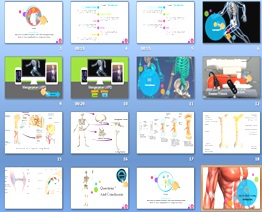
Difficulties in the Material of Skeleton Systems and the Application of ICT in Learning Natural Sciences (IPA)
Abstract
Keywords
Full Text:
PDFReferences
Akik H., & Amir M., (2017). Pembelajaran Bentuk Sendi Tulang Manusia Menggunakan Konsep Augmented Reality. Jurnal Siliwangi Seri Pendidikan. 3 (1), 204-208
Alimisis, D., (2013). Educational robotics: Open questions and new challenges. Themes in Science and Technology Education, (1) 6, 63-71.
Allen, M., (2014). Misconceptions in primary science. Berkshire, UK: Open University Press.
Angela K. H., Travis J. H., Frank S., Matthew R. B., & Megan A., (2019). Information technology pathways in education: Interventions with middle school students. Computers & Education. (135) 49–60.
Bambang, S., (2012). Penggunaan Teknologi Informasi dan Komunikasi Dalam Pengajaran : Survey Pada Guru-Guru Sains SMP di Indonesia. Johor Bahru: Fakulti Pendidikan,Universiti Teknologi Malaysia. 122-131
Buckley, B. C. (2000). Interactive multimedia and model-based learning in biology. International Journal of Science Education, 22 (9), 895-935.
Della, L., Dezi H., Rahmawati D., & Armen. (2018). Identifikasi Miskonsepsi Peserta Didik Kelas VIII SMPN 21 Padang pada Materi Sistem Gerak Makhluk Hidup Menggunakan Teknik CRI. Atrium Pendidikan Biologi. Prodi Pendidikan Biologi, FMIPA, Universitas Negeri Padang. 1 (2), 135-142.
Ertan, T., & Gürcan Ç., (2019). Using Artificial Intelligence for Modeling of the Realistic Animal Behaviors in a Virtual Island. Computer Standards & Interfaces. 66 , 1-11
Gatt, S., & Saliba, M., (2006). Young children’s ideas about the heart. In M. F. Costa, & B. V.Dorrío (Eds.), Proceedings of the 3rd International Conference on Hands-on Science. Science Education and Sustainable Development. 17-23.
George, S., & Leroux, P., (2001). Project-based learning as a basis for a CSCL environment: An example in educational robotics. First european conference on computer-supported collaborative learning (Euro-CSCL). Maastricht McLuhan Institute. 269-279
Haßler, B., Major, L., & Hennessy, S., (2015). Tablet use in schools: a critical review of the evidence for learning outcomes. Journal of Computer Assisted Learning, 32 (2), 139-156.
Huminca S., (2016). Pendidikan Sains Singapura Terunggul di Dunia. http://www.pikiran-rakyat.com/pendidikan/2016/12/08/pendidikan-sains-di-singapura-terunggul-sedunia-387214 [diakses pada tanggal 16 Agustus 2018 pukul 08.17 wib].
Karuniakhalida, P., Maimunah, & Murni, A. (2019). Development of ICT Based Mathematical Media on Linear Program Materials to Improve Motivation Learning Students. Journal of Educational Sciences, 3 (2), 195- 204.
Li, M., & Reimers, K., (2015). Innovation in China’s information and communications technology industry. Chinese Management Studies, (9) 1, 27 - 37.
Maud, C., Aleksandr, K., K., & Anna B., (2018). Artificial Intelligence trends in education: a narrative overview. Procedia Computer Science. (136) 16–24.
Michael., H., K., Suharjito, Diana, & Gunawan W., (2018). Human Anatomy Learning Systems Using Augmented Reality on Mobile Application. Procedia Computer Science. (135) 80–88.
Mintzes, J., J., (1984). Naïve theories in biology: Children’s concepts of the human body. School Science and Mathematics, 84 (7), 548-555.
Moonhyun, H., & Heui-baik K., (2017). Elementary Students’ Modeling Using Analogy Models to Reveal the Hidden Mechanism of the Human Respiratory System. Int J of Sci and Math Educ. 1-20
Ozgur, S., (2013). The persistence of misconceptions about the human blood circulatory system among students in different grade levels. International Journal of Environmental & Science Education, 8 (2), 255-268.
Refni, W, Hendry, F., & Resky, P., I. (2018). Aplikasi Media Pembelajaran Sistem Gerak Manusia Pada Pelajaran IPA Terpadu Di SMP Pondok Pesantren Babusalam. Jurnal Ilmu Komputer (JIK). 7 (2), 79-91
Reiss, M., J., & Tunnicliffe, S., D. (2001). Students’ understandings of human organs and organ systems. Research on Science Education, 31(3), 383-399.
Richa, B., & Vidushi, S. (2018). Learning Styles Smart Education with Artificial Intelligence based determination of learning styles. Procedia Computer Science. (132) 834–842.
Roza, L., Abdullah, Nur, S., Fitri, A., D., & Praslita, D. (2018) Development of interactive multimedia based on Lectora Inspire in chemistry subject in junior high school or madrasah tsanawiyah. Journal of Educational Sciences. 2 (1), 46-55.
Tracana, R., B., Varanda, I., Viveiros, S., & Carvalho, G., S. (2012). Children’s conceptions about respiration before and after formal teaching: identification of learning obstacles. Proceedings of the XV IOSTE Symposium (International Organization for Science and Technology Education)-The use of Science and Technology Education for Peace and Sustainable Development, 1-11.
Wahyuni, T. (2016). Analisis Miskonsepsi Materi Sistem Gerak Manusia Pada Peserta Didik Kelas XI MIA Menggunakan Tes Diagnostik Three-Tier multiple Choice. Jurnal Bioedu. 5 (3), 220-225
Yenita, R., Putri, Y., Sehatta, S., Hadiyanta, A., & Andespa, S., (2017) Computer-Based Media for Learning Geometry at Mathematics Class of Secondary Schools. Journal of Educational Sciences. 1 (1), 79-91.
Zulfiani, S., & Noor. (2014). Identifikasi Miskonsepsi Siswa Pada Konsep Archaebacteria Dan Eubacteria MenggunakanTwo-Tier Multiple Choice. Jurnal Edusains. 6 (2), 191-200
DOI: http://dx.doi.org/10.31258/jes.4.1.p.187-199
Refbacks
- There are currently no refbacks.
Copyright (c) 2020 Irfan Andi Gafur, Yustina Yustina, Zulfarina Zulfarina

This work is licensed under a Creative Commons Attribution 4.0 International License.
Publisher: FKIP Universitas Riau












